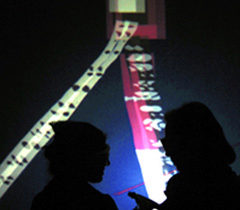Kites Flying In and Out of Space
May 1st, 2002 - September 26th, 2002
Categories: Applications, Tele-Immersion, VR Art

About
Kites Flying In and Out of Space is a seminal work, as the first high bandwidth virtual-reality art piece ever created.
The content is a study and replication of the flying kinetic artwork of Jacqueline Matisse-Monnier. The piece was exhibited at the iGRID2002 Conference September 23-26th 2002, hosted by SARA in Amsterdam, Netherlands.
The complexity involved with calculating and rendering data is facilitated by distributed computing over high-speed networks. Because the calculations for these kinetic art pieces (kites) are so computationally intensive, a single PC can only support the simulation of one kite.
To support the many kites flown at iGrid, collaborators with computing resources around the world are performing the physically-based kite simulations at their home institutions and then streaming the results of the calculations, in real time, to Amsterdam.
In essence, this is grid computing for the arts.
Kites Flying In and Out of Space utilizes a “Grid” model for real time steering of calculations on computers distributed over high-speed networks.
Each of the 12 kites appearing in the piece utilizes up to 15 megabits per second. This art piece uses a total of approximately 180 megabits per second in calculating the forms and theoretically could utilize even more.
CAVEs around the world could potentially view this application through a connection to the Starlight high-speed networking program. The kite structures are so complex to simulate that a distributed computational model using processors on multiple machines is needed.
Kites Flying In and Out of Space enlists servers distributed across the globe in Chicago, Canada, Japan, Singapore and Virginia to calculate its forms. Each of these servers “stream” a single kite to SARA in Amsterdam where they are then displayed in a CAVE.
A participant in the CAVE presentation can manipulate the kites and control the wind. When a person injects wind into the scene, messages are sent to all the servers. These messages contain information regarding wind direction and strength. The servers then calculate the modifications to their individual kite structures. That information is then streamed back into the CAVE. This process is called real time simulator steering and it is the basis for the steering of high performance calculations on super computers distributed over a high-speed network.
This “grid” model has never been used for art prior to Kites Flying In and Out of Space. It is an example of “Grid” computing, resulting in an original, seminal work of art.